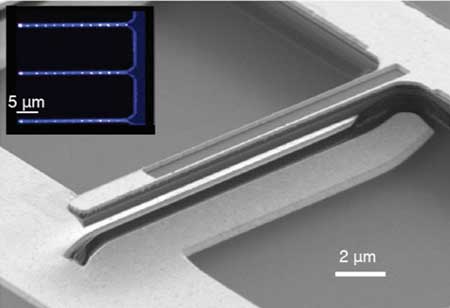| Feb 14, 2019 | |
Taking diamond qubits for a spin(Nanowerk News) By implanting silicon ions in diamond with extreme precision and then controlling the strain on the crystal structure, scientists showed that they could significantly increase the spin lifetimes of solid-state quantum bits. This is of fundamental importance to quantum mechanics and quantum computing. |
|
 |
|
| A scanning electron microscope image of a single-crystal diamond cantilever. This tiny device allows scientists to exert control over a quantum system. (© NPG) | |
| Quantum networks could change how we produce and send data. Creating such networks requires generating single phonons—the vibrational motion that characterizes single atoms and nonclassical mechanical states. | |
| This work opens the door to achieving a long sought-after goal: deterministically producing phonons. These phonons could be used to interface with other quantum systems such as superconducting qubits. The strain engineering approach developed in this research can also be applied to other quantum emitters and be used to generate scalable quantum networks. | |
| Solid-state quantum bits, or qubits, offer scalability in a quantum network. Such networks could change how computations are done and how data is sent. | |
| However, the uncontrolled interaction of a quantum system with its environment can cause the quantum states to collapse, a.k.a. quantum decoherence. | |
| While there are a range of techniques available to reduce environmental effects, overcoming thermal decoherence is more challenging. Typically, the only effective strategy is to maintain the quantum system at extremely low temperatures. | |
| In Nature Communications ("Controlling the coherence of a diamond spin qubit through its strain environment"), a team shows a different approach to solving this problem. | |
| They started with the negatively charged silicon-vacancy center in a diamond, an emerging building block for photonic quantum networks. Scientists created these silicon-vacancy centers at the Center for Integrated Nanotechnologies using a focused ion beam to precisely implant silicon ions in an array on a diamond substrate. | |
| Normally this type of device would be subject to thermal decoherence unless the quantum system is operated at ultracold temperatures. Instead of lowering the temperature, the team took advantage of the fact that the electron-phonon coupling, which is the cause of the thermal decoherence, arises from a high susceptibility of the electronic orbitals to lattice strain. | |
| They devised a way to increase the strain. They achieved this with a nano-electro-mechanical system device—a single-crystal diamond cantilever with metal electrodes patterned above and below it. An opening in the top electrode allows optical access to the silicon-vacancy qubits. A direct current voltage applied across the electrodes deflects the cantilever downwards and generates controllable static strain. Through strain control, the team reduced the electron-phonon coupling and demonstrated six-fold improvement in the spin coherence time. |
| Source: U.S. Department of Energy, Office of Science | |
|
Subscribe to a free copy of one of our daily Nanowerk Newsletter Email Digests with a compilation of all of the day's news. |
